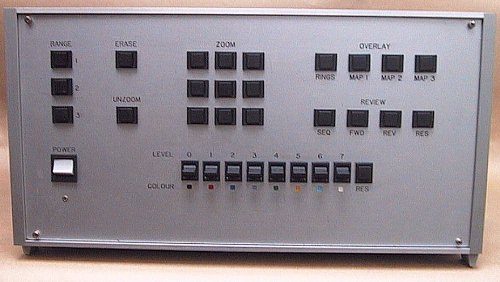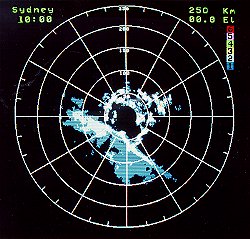

The Rapic Receiver was the first colour raster scan display developed in-house.
Design work was started in 1982 and by the end of life in the late 1980's about
50 units had seen service. The last 20 were made under contract by MACE in Sydney
who also manufacted a few for private industry.
GENERAL DESCRIPTION
The Rapic Receiver provided a quantitative display in colour of weather radar
data, remote from the radar site. The display utilised a high-resolution colour
monitor. This meant unlike the traditional PPI (plan position display) the display
could be viewed under normal office lighting conditions thus a special darkened
room was no longer required for radar operations .
As well as providing a conventional PPI display, the unit included map outlines and time lapse sequence facilities.
 It
received its data from the radar over a two-wire line and this data took a little
more than two minutes to receive the radar picture. Each display of one complete
radar azimuth sweep, was stored in the unit's internal memory prior to display.
The memory held fifteen such pictures and when the sixteenth picture was received
the earliest picture is discarded. The time between each picture was set by
the transmitting equipment at the radar site. Typically this was 2 or 10 minutes
depending on the type of transmitting equipment.
It
received its data from the radar over a two-wire line and this data took a little
more than two minutes to receive the radar picture. Each display of one complete
radar azimuth sweep, was stored in the unit's internal memory prior to display.
The memory held fifteen such pictures and when the sixteenth picture was received
the earliest picture is discarded. The time between each picture was set by
the transmitting equipment at the radar site. Typically this was 2 or 10 minutes
depending on the type of transmitting equipment.
The display's captions indicated the displayed range, the time and the radar elevation angle when the picture was generated. The picture could be expanded in nine quadrants for closer examination of any particular area of interest.
Rainfall intensity levels were displayed in colour on the monitor, the choice of colours being made by the operator. The intensity levels were set at the radar, and initially these levels were dependant on which type of radar the Rapic receiver was connected to. In October 1986(1) the first set of levels was established as the standard for all radars across the nation.
|
LEVEL
|
RAINFALL
RATE (mm/hr)
|
|
|
|
WF44
|
WF100, |
|
1
|
0.3 - 2
|
0.3 - 2
|
|
2
|
2 - 10
|
2 - 25
|
|
3
|
10 - 20
|
25 - 50
|
|
4
|
20 - 40
|
50 - 100
|
|
5
|
40 - 100
|
100 - 250
|
|
6
|
100 +
|
250 +
|
References
(1) File note from A.L.West